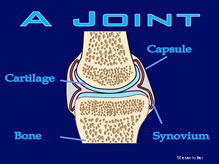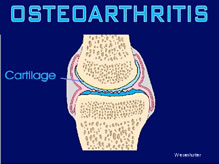U.C.L.A. Rheumatology Pathophysiology of Disease Course Lecture,
Second Year Medical School 1997
critical function (hand) that it should be considered a disease. Unfortunately, this process is so universal that the symptoms of OA are one of the most common reasons for people to see a doctor.
Osteoporosis is one of the most common bone diseases of man. About 50% of women will develop significant osteoporosis some time in their life. Osteoporosis is a conditions in which there is an abnormally low bone mass as well as a microarchitectual defect in bone leading to increased bony fragility (figure 5).
Osteoporosis is analogous to hypertension clinically in that the problem worsens over many years but remains asymptomatic until the clinical course is punctuated by a catastrophic event. In the case of osteoporosis, it is a bony fracture, often caused by fairly minimal trauma.
There are several variables which effect ones predisposition to this disease, including genetic tendencies, and numerous environmental factors, such as the exposure to certain toxins (smoking, alcohol), drugs (thyroid), as well as the lack of exposure to the beneficial effects of estrogen (postmenopausal osteoporosis).
The methods for diagnosis and treatment of osteoporosis have recently greatly improved, which has made this condition one of the more gratifying to manage in the clinic

